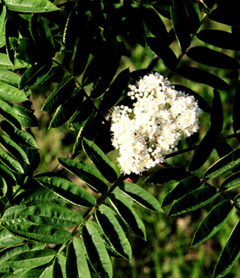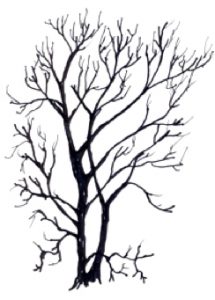Bulletin #2582, Native Trees and Shrubs for Maine Landscapes: Showy Mountain Ash (Sorbus decora)
Developed by Marjorie Peronto, Associate Extension Professor, University of Maine Cooperative Extension; and Reeser C. Manley, Assistant Professor of Horticulture, University of Maine.
For information about UMaine Extension programs and resources, visit extension.umaine.edu.
Find more of our publications and books at extension.umaine.edu/publications/.
Go native!
This series of publications is the result of a five-year research project that evaluated the adaptability of a variety of native trees and shrubs to the stresses of urban and residential landscapes in Maine. Non-native invasive plants pose a serious threat to Maine’s biodiversity. Plants such as Japanese barberry, shrubby honeysuckle, and Asiatic bittersweet, originally introduced for their ornamental features, have escaped from our landscapes, colonizing natural areas and displacing native plants and animals. By landscaping with native plants, we can create vegetation corridors that link fragmented wild areas, providing food and shelter for the native wildlife that is an integral part of our ecosystem. Your landscape choices can have an impact on the environment that goes far beyond your property lines.
Description

Form: a small tree with ascending branches that form low to the ground
Size: 20 to 35 feet high, up to three-fourths as wide
Ornamental characteristics:
- broad, flat-topped terminal clusters of white flowers in late May or early June
- heavy, drooping terminal clusters of bright scarlet red or orange berries from mid-August through October
Landscape Use

Showy mountain ash can tolerate a wide range of soil moisture conditions, from poorly drained to well-drained, and thus can be found growing in swamps and bogs as well as on moist, rocky hillsides. Intolerant of shade, it frequents open hillsides and lake shores, growing with gray birch (Betula populifolia), paper birch (B. papyrifera), balsam fir (Abies balsamea), quaking aspen (Populus tremuloides), and red maple (Acer rubrum).
Because mountain ash is sensitive to many root-zone stresses, including drought, heat, and soil compaction, it should be mulched to maintain a cool, moist, acidic soil. The mulch should spread out beyond the trunk at least twice as far as the tree’s drip line (the edge of its canopy) in order to shelter the extensive root system.
This native species of mountain ash is equally as ornamental, both in flower and fruit, as the more commonly used European mountain ash (Sorbus aucuparia), and is far more resistant to disease.
Culture

Hardiness: USDA zone 2
Soil requirements: tolerates a wide variety of soils
Light requirements: full sun
Stress tolerances:
soil compaction — intolerant
pollution — intolerant
deicing salts — intolerant
urban heat islands — intolerant
drought — intolerant
seasonal flooding — tolerant
Insect and disease problems: frequent — fire blight, scab, cankers, borers, crown gall, pear leaf mite, mountain ash sawfly, and scale
Wildlife Value
The berries of mountain ash are eaten by waterfowl, and game birds such as ruffed grouse. Songbirds known to eat the berries include yellow-bellied flycatchers, cedar waxwings, thrushes, and grosbeaks. The fruits are also eaten by both small and large mammals, including humans.
Maintenance
Irrigation: During the establishment period, defined as one year after planting for each inch of trunk diameter at planting time, water your trees regularly during the growing season. Give the root zone of each tree 1 inch of water per week; in general, a tree’s root zone extends twice as wide as its canopy. After the establishment period, provide supplemental irrigation during periods of severe drought.
Fertilization: Landscape trees and shrubs should not be fertilized unless a soil test indicates a need. Correct soil pH, if necessary, by amending the backfill soil. No nitrogen fertilizer should be added at planting or during the first growing season.
To learn more about native woody plants
Visit the Eastern Maine Native Plant Arboretum at University of Maine Cooperative Extension’s Penobscot County office, 307 Maine Avenue in Bangor. Established in 2004, the arboretum displays 24 different native tree and shrub species that can be used in managed landscapes.
Reviewed by Cathy Neal, Extension professor, University of New Hampshire Cooperative Extension.
Photos by Reeser C. Manley.
Illustration by Margery Read, Extension Master Gardener.
 This series of publications and the associated research were made possible in part by the Maine Forest Service’s Project Canopy.
This series of publications and the associated research were made possible in part by the Maine Forest Service’s Project Canopy.
Information in this publication is provided purely for educational purposes. No responsibility is assumed for any problems associated with the use of products or services mentioned. No endorsement of products or companies is intended, nor is criticism of unnamed products or companies implied.
© 2008
Call 800.287.0274 (in Maine), or 207.581.3188, for information on publications and program offerings from University of Maine Cooperative Extension, or visit extension.umaine.edu.
The University of Maine is an EEO/AA employer, and does not discriminate on the grounds of race, color, religion, sex, sexual orientation, transgender status, gender expression, national origin, citizenship status, age, disability, genetic information or veteran’s status in employment, education, and all other programs and activities. The following person has been designated to handle inquiries regarding non-discrimination policies: Sarah E. Harebo, Director of Equal Opportunity, 101 North Stevens Hall, University of Maine, Orono, ME 04469-5754, 207.581.1226, TTY 711 (Maine Relay System).

